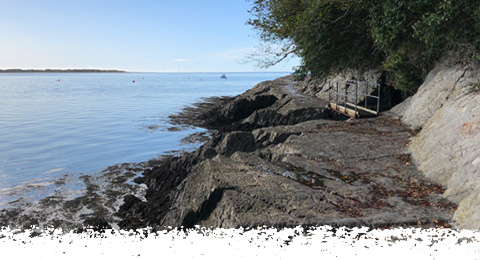
Old Roman Road (Coast Path)

Old Roman Road
Penhelig, Aberdovey
The Old Roman Road nr. Aberdovey is a coastal footpath for walkers and explorers.
The path is carved out of the local mudstone (take care and wear suitable footwear – slippy when wet), a remarkable feat that even the Romans, accomplished civil engineers, would have found difficult without the help of explosives. The nearest Roman military structure was Cefn Caer at Pennal, 11km to the east along the Dyfi.
Author Dai Roberts, an Aberdovey resident, states that the track was built in 1808 for horse and carriage, but he doesn’t say where these were headed and why such a road would be required. Even Hugh M. Lewis, born in 1910, and grew up and lived in Aberdovey was unable to shed any more light on the subject.
Whenever the ‘Old Roman Road’ was built and whatever it was used for, it is invaluable today as a coastal footpath for walkers and explorers. The path has two small bridges that cross little natural outlets for fresh water that pours down the hills into the estuary. The estuary can be incredibly peaceful on a sunny day as the tide retreats, the water flat and sparkling, lapping gently at the rocks as it travels at a considerable pace to the west. The hills beyond, in Ceredigion, fresh and green, are the perfect backdrop.


Old Roman Road
(Coast Path)

The Old Roman Road nr. Aberdovey is a coastal footpath for walkers and explorers.
The path is carved out of the local mudstone (take care and wear suitable footwear – slippy when wet), a remarkable feat that even the Romans, accomplished civil engineers, would have found difficult without the help of explosives. The nearest Roman military structure was Cefn Caer at Pennal, 11km to the east along the Dyfi.
Author Dai Roberts, an Aberdovey resident, states that the track was built in 1808 for horse and carriage, but he doesn’t say where these were headed and why such a road would be required. Even Hugh M. Lewis, born in 1910, and grew up and lived in Aberdovey was unable to shed any more light on the subject.
Whenever the ‘Old Roman Road’ was built and whatever it was used for, it is invaluable today as a coastal footpath for walkers and explorers. The path has two small bridges that cross little natural outlets for fresh water that pours down the hills into the estuary. The estuary can be incredibly peaceful on a sunny day as the tide retreats, the water flat and sparkling, lapping gently at the rocks as it travels at a considerable pace to the west. The hills beyond, in Ceredigion, fresh and green, are the perfect backdrop.
Old Roman Road
Penhelig, Aberdovey


Old Roman Road
(Coast Path)
The Old Roman Road nr. Aberdovey is a coastal footpath for walkers and explorers.
The path is carved out of the local mudstone (take care and wear suitable footwear – slippy when wet), a remarkable feat that even the Romans, accomplished civil engineers, would have found difficult without the help of explosives. The nearest Roman military structure was Cefn Caer at Pennal, 11km to the east along the Dyfi.

Author Dai Roberts, an Aberdovey resident, states that the track was built in 1808 for horse and carriage, but he doesn’t say where these were headed and why such a road would be required. Even Hugh M. Lewis, born in 1910, and grew up and lived in Aberdovey was unable to shed any more light on the subject.
Whenever the ‘Old Roman Road’ was built and whatever it was used for, it is invaluable today as a coastal footpath for walkers and explorers. The path has two small bridges that cross little natural outlets for fresh water that pours down the hills into the estuary. The estuary can be incredibly peaceful on a sunny day as the tide retreats, the water flat and sparkling, lapping gently at the rocks as it travels at a considerable pace to the west. The hills beyond, in Ceredigion, fresh and green, are the perfect backdrop.
Old Roman Road
Penhelig, Aberdovey

MORE PLACES OF INTEREST…